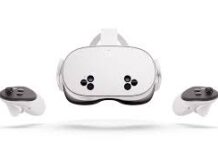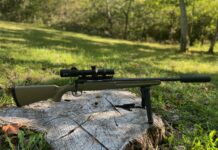http://www.youtube.com/watch?v=E-o8rI6ZEWs
Tiger McKee at tacticalwire.com writes:
When it comes to long guns, one of the most common issues we see is shooters not getting the stock of the weapon in the actual pocket of the shoulder. This creates several problems. If you’re firing something with serious recoil, especially shotguns, the stock will slam into the shoulder with enough force to bruise. The stock needs to be in the pocket for accuracy, creating a consistent platform and efficient recovery from recoil for follow-up shots. Getting the stock located in the pocket is also crucial for efficiency. When you bring the muzzle up and obtain a cheek weld against the stock the sights should fall into alignment with your eyes, without having to reposition your head . . .
To find your pocket, bring the right arm up – for right-hand shooters – so it’s angled ninety degrees to the body, bending the elbow so the hand is positioned where it would be if holding the grip of the gun. Take your support hand, holding the fingers straight, and find the high point on the front of the collarbone.
Now slide the hand outboard, towards the shoulder, following the radius of the collarbone. Your hand will dip down, or inward, and keep sliding until you hit the deltoid muscle of the shoulder. This low spot is your pocket, and where the heel of the stock should be positioned.
How much of the stock you have in the pocket, or the height of the stock, depends on what type weapon you’re firing. The idea is that when you bring the muzzle onto target and obtain a cheek weld on the stock the sights should be aligned with your eyes. For guns with low sights, such as shotguns, the entire heel will be in the shoulder.
The same position holds true for a bolt-action rifles, even those with optics higher than the barrel. Unless your stock is adjustable or has a raised comb you’ll have to add material to the stock, raising the comb of the stock so you can get a proper cheek weld. A cheek pad -Brownells # 851-200-500 – works well for this. In the field you can use duct tape and foam pipe insulation.
AR’s are completely different. Due to the rifle’s design and offset between the sights and barrel only about the bottom half of the stock’s heel should be in the shoulder. This allows you to hit a solid, consistent cheek weld and obtain a good sight picture without having to reposition your head and eyes. If you put the stock too low in your pocket you have to shove your head forward or tilt it sideways to obtain a sight picture. Neither one of these options are good.
The key, as always, is consistency, and consistency is the result of practice. Dry practice is best. You start in the low ready position, stock properly positioned in the pocket and muzzle depressed, visually focusing on the exact point you want to place the shot. You bring the muzzle up and obtain a solid cheek weld. The sights should now be in alignment with the eyes. Lower the muzzle down, and repeat, over and over, until it becomes natural.
Tiger McKee is director of Shootrite Firearms Academy, located in northern Alabama. He is the author of “The Book of Two Guns,” writes for several firearms/tactical publications including (now) TTAG.




Always seems to me that if a long gun – any long gun – is situated properly in my shoulder pocket, I have to tilt my head down/forward to get a proper sight picture, especially with a bead-sight on a shotgun. I’d have to sit about half of the heel or less in my shoulder pocket in order to not move my head much for a sight picture.
Lower sights are closer to bore axis, yes? And bore axis being closer to in-line with the top of the stock means that unless you have a really really short neck, you have to tilt your head down/forward to get a sight picture. Or am I just a freak with a really long neck?
I think I have the same issue. I use an EOTech 517.a65 with a 3xMagnifier. Because of the eye relief of the magnifier I use the charging handle and the tip of my nose as an indexing point. If the stock is in position 1 or 2, I have to tilt my head more, but if I move it back a little bit to position 3 or 4, and I feel like it’ sticking out to far forward. This changed slightly when I started use postion 2 or 3 after adding a Magpul “enhanced” butt pad.
I have about 10 minutes experience with an AR pattern rifle, so I can’t really say with any certainty how they’d fit me. I know my .30-30’s sights don’t line up anywhere near my line of sight if I get the heel fully into the pocket, the 12ga isn’t quite as bad, but I’ve still got at least an inch, maybe 2 of heel that’s not in the pocket at all.
I really need to get some rifle training so this isn’t so very applicable for me. Noobies of the gun world… UNITE! …with all muzzles pointed down range.
Thanks for the tip.
Thanks for tips. Google Appleseed for great rifle training.
“AR’s [sic] are completely different. Due to the rifle’s design and offset between the sights and barrel only about the bottom half of the stock’s heel [sic] should be in the shoulder.”
No to be picky but it should read:
ARs are completely different. Due to the rifle’s design and offset between the sights and barrel only about the bottom half of the stock’s butt should be in the shoulder.
OK, yes, I am being picky! And yes again, I knew what you meant.
You can always spot those who are not former military. Just watch how they handle the weapon and fire it.
When “they” went to Canada I reported. Best training money can buy. Never handled a weapon till they called number. Been a gun guy ever since.
For the younger crowd the “they” are those who dodged the draft and the deserters who went to Canada. The ones Jimmy Carter gave unconditional pardons to on Jan 21, 1977 on his first day in office.
If you can swing it, get to Shootrite. It is great practical firearms training for anyone from novice to law enforcement. Tiger is an outstanding instructor and you won’t be disappointed!
Wow, this link gave my video almost 1000 views in one day. That is the single biggest bump ever, except the time a video of my son shooting got linked on some liberal mommy forum.
Thanks
Buttstock in the pocket of the shoulder
Correct placement of the buttstock in the shoulder pocket lessens the effect of recoil and helps steady the weapon allowing faster follow-up shots. Here’s how to find your shoulder pocket: raise the strong elbow above the shoulder, place the fingers of your other hand under your raised armpit, and feel for the pocket with the thumb.
You are 100% wrong about how to good an AR… But that’s just my near decade of experience being properly trained from special operations on how to fire it talking.
You are 100% wrong about how to hold an AR…But that’s just my near decade of experience and special operations training on how to properly fire it for combat talking…
Thankѕ for another magnificent articlе. Where else may
just anyone get that kind of information in such a perfect means of writing?
I’ve a presentation subsequent week, and I am at the search for ѕuch info.
It would be nice to know and use proper termonolgy here. What you are calling the heel of the stock is actually the toe. Your instructions are 100 percent backwards.
Yes, I am sure most could figure out what you are saying about stock placement but a true expert would know the difference.
Additionally, few long guns allow a fully engaged butt stock placement and the head position you state. It they did whilst sranding, they would be useless in sitting or prone.
Stock design requires tradeoffs.
Comments are closed.